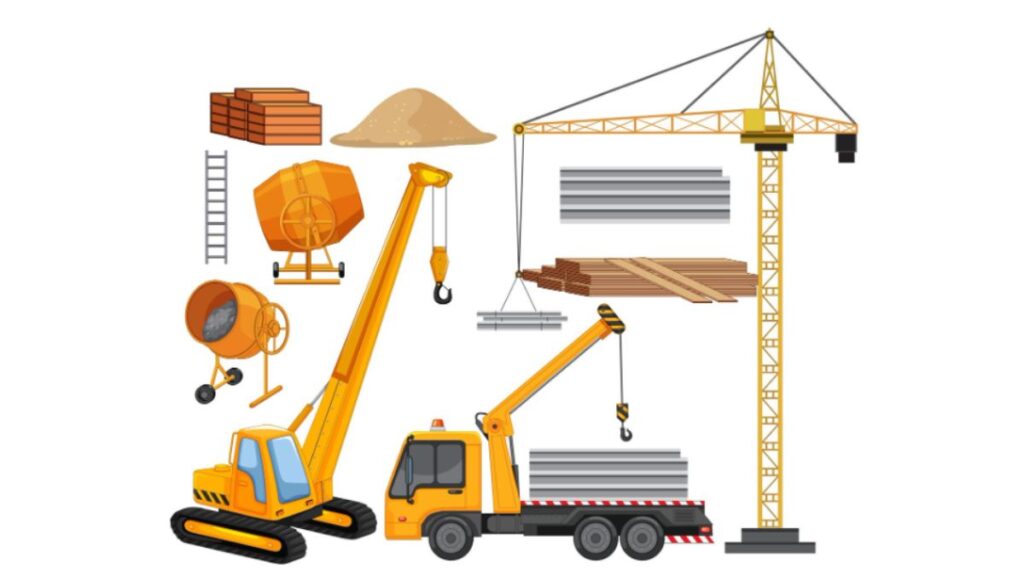Lifting equipment, from simple pulleys to advanced cranes, is essential for moving heavy materials in construction and industrial settings. These machines rely on basic mechanical principles combined with advanced engineering to ensure precision and safety. Understanding how they work is crucial for operators, engineers, and safety managers to ensure proper use, maintenance, and safe operations.
Basic Mechanical Principles
The most fundamental concepts in lifting equipment design stem from simple machines that amplify human effort. These principles form the building blocks for more complex systems.
Leverage: Multiplying Force
Leverage operates on the principle that a small force applied over a longer distance can move a larger load over a shorter distance. In lifting equipment, levers appear in various forms, from the boom of a crane to the handle of a manual hoist.
The mechanical advantage of a lever depends on the ratio between the effort arm and the load arm. For example, a crane boom acts as a first-class lever, with the fulcrum at the base, the load at the end, and the lifting force applied through cables and counterweights. The longer the boom, the greater the mechanical advantage, but this also increases the moment load on the base structure.
Pulleys: Changing Direction and Reducing Force
Pulley systems revolutionize lifting by allowing operators to change the direction of applied force and reduce the effort needed to lift heavy loads. A fixed pulley simply changes direction, while movable pulleys provide mechanical advantage.
Block and tackle systems combine multiple pulleys to create significant mechanical advantages. Each rope supporting the load reduces the force required proportionally. A four-part line system, where four rope segments support the load, reduces the required lifting force to one-fourth of the load weight, though the rope must be pulled four times the distance the load travels.
Inclined Planes: Gradual Load Movement
The inclined plane principle appears in ramps, conveyor systems, and loading docks. By extending the distance over which a load is moved, inclined planes reduce the force required to lift objects to higher elevations.
The mechanical advantage of an inclined plane equals the length of the slope divided by the height. A ramp that’s 10 feet long to reach a height of 2 feet provides a mechanical advantage of 5:1, meaning only one-fifth the force is needed compared to lifting straight up. Similarly, equipment like the Potain self-erecting tower crane leverages mechanical principles to handle heavy loads efficiently, making construction tasks much easier.
Hydraulic Systems
Modern lifting equipment increasingly relies on hydraulic systems, which offer tremendous power in compact packages while providing smooth, controllable operation.
Pascal’s Law: The Foundation of Hydraulic Power
Pascal’s Law states that pressure applied to a confined fluid is transmitted equally in all directions. This principle enables hydraulic systems to multiply force dramatically. When force is applied to a small piston, it creates pressure throughout the hydraulic fluid, which acts on a larger piston to produce greater output force.
The force multiplication equals the ratio of the piston areas. If the output piston has 10 times the area of the input piston, the system multiplies the applied force by 10. However, the input piston must move 10 times farther than the output piston, conserving energy while trading distance for force.
Components: The Heart of Hydraulic Systems
Hydraulic lifting systems consist of several critical components working in harmony. Hydraulic pumps pressurize the fluid, typically specialized hydraulic oil chosen for its viscosity, temperature stability, and anti-corrosion properties.
Cylinders convert hydraulic pressure into linear motion. Single-acting cylinders extend under pressure and retract by gravity or spring force, while double-acting cylinders can both extend and retract under power. The cylinder bore diameter determines the force output, while stroke length determines the range of motion.
Control valves regulate fluid flow and pressure, enabling precise control of lifting speed and positioning. Relief valves protect the system from overpressure, while check valves prevent fluid backflow that could cause uncontrolled load descent.
Applications: Hydraulic Cranes and Lifts
Hydraulic systems excel in applications requiring smooth, controlled lifting with high power-to-weight ratios. Mobile cranes use hydraulic systems for boom extension, load lifting, and outrigger deployment. The ability to provide variable speed control makes hydraulics ideal for precision positioning.
Scissor lifts demonstrate hydraulic principles clearly, using cylinders to extend crossed arms that raise the platform. The mechanical advantage of the scissor mechanism multiplies the hydraulic force while providing stable, level lifting.
Cable and Winch Systems
Steel cables and winching systems provide reliable lifting power, especially for heavy-duty applications where precise control and high load capacities are essential.
Cable Mechanics: Understanding Load Limits
Wire rope construction significantly affects lifting capacity and safety. Cables consist of individual wires formed into strands, which are then twisted together around a core. The core may be fiber, which provides flexibility, or steel, which offers greater strength and crush resistance.
Cable strength depends on construction, material grade, and diameter. However, the working load limit is typically much lower than breaking strength to provide an adequate safety factor. Standard safety factors range from 5:1 for personnel lifting to 3:1 for material handling, depending on application and regulations.
Load capacity also depends on cable condition. Broken wires, corrosion, kinks, or worn areas dramatically reduce safe working loads. Regular inspection protocols identify these defects before they compromise safety.
Winch Operations: Gear Systems and Load Control
Winches use gear reduction to multiply the input force from electric motors or manual operation. Worm gear systems are common because they provide high reduction ratios and are self-locking, preventing load backslip when power is removed.
Load capacity calculations must account for drum diameter, as smaller drums increase cable stress and reduce capacity. The cable’s bend radius over the drum affects its fatigue life, with tighter bends causing earlier failure.
Modern winches often incorporate load monitoring systems that display actual load weights and warn operators of approaching capacity limits. These systems improve safety while maximizing equipment utilization.
Safety: Inspection and Maintenance Protocols
Cable inspection requires systematic examination of the entire rope length. Inspectors look for broken wires, corrosion, wear, kinks, and core damage. Documentation tracks cable condition over time, enabling predictive maintenance and replacement before failure.
Proper lubrication extends cable life by reducing internal friction between wires. However, over-lubrication can attract dirt and debris that accelerate wear. The lubricant type must be compatible with the cable construction and operating environment.
Structural Integrity
Lifting equipment must safely support not only the intended load but also dynamic forces from wind, acceleration, and operation.
Material Strength: Understanding Limits
Yield strength represents the stress level at which materials begin permanent deformation. For lifting equipment, operating stresses must remain well below yield strength to maintain structural integrity. Tensile strength indicates the ultimate failure point, but designs target much lower stress levels.
Safety factors account for uncertainties in loading, material properties, and wear over time. Structural components typically use safety factors of 2:1 to 4:1, depending on the criticality and predictability of loads.
Material selection considers not only strength but also fatigue resistance, corrosion resistance, and temperature effects. High-strength steels may be more susceptible to brittle failure under certain conditions, requiring careful analysis of operating environments.
Load Distribution: Spreading Forces
Proper load distribution prevents stress concentrations that could cause premature failure. Wide flanges, gussets, and reinforcing plates distribute loads over larger areas, reducing local stresses.
Base structures must distribute lifting loads into supporting foundations or ground conditions. Outriggers spread loads over larger areas while providing stability against overturning moments. Float pads further distribute loads when ground conditions are soft.
Stability: Preventing Overturning
Lifting equipment stability depends on the relationship between the center of gravity and the support base. As loads increase or extend farther from the centerline, overturning moments increase proportionally.
Load charts define safe operating envelopes based on boom length, angle, and counterweight configuration. These charts ensure that the overturning moment never exceeds the restoring moment provided by the equipment’s weight and counterweights.
Safety and Compliance
Regulatory standards and safety protocols provide frameworks for safe lifting operations, but understanding the underlying principles enables better decision-making.
Safety Standards: Regulatory Framework
OSHA regulations establish minimum safety requirements for lifting equipment, including inspection schedules, operator training, and operational limits. ANSI standards provide detailed technical specifications for equipment design, testing, and maintenance.
These standards evolve based on industry experience and accident analysis. Recent updates emphasize operator training, load moment systems, and documentation requirements that improve accountability and safety awareness.
Inspection: Preventive Maintenance
Regular inspections identify wear, damage, and deterioration before they compromise safety. Daily pre-use inspections check obvious defects, while periodic detailed inspections examine internal components and structural elements.
Documentation systems track inspection results, maintenance actions, and equipment history. This data enables predictive maintenance strategies that improve reliability while reducing costs compared to reactive maintenance approaches.
Conclusion
Lifting equipment relies on fundamental mechanical principles that remain crucial despite advancements in automation and smart sensors. Understanding these principles ensures safety, efficiency, and effective design for operators and engineers.







